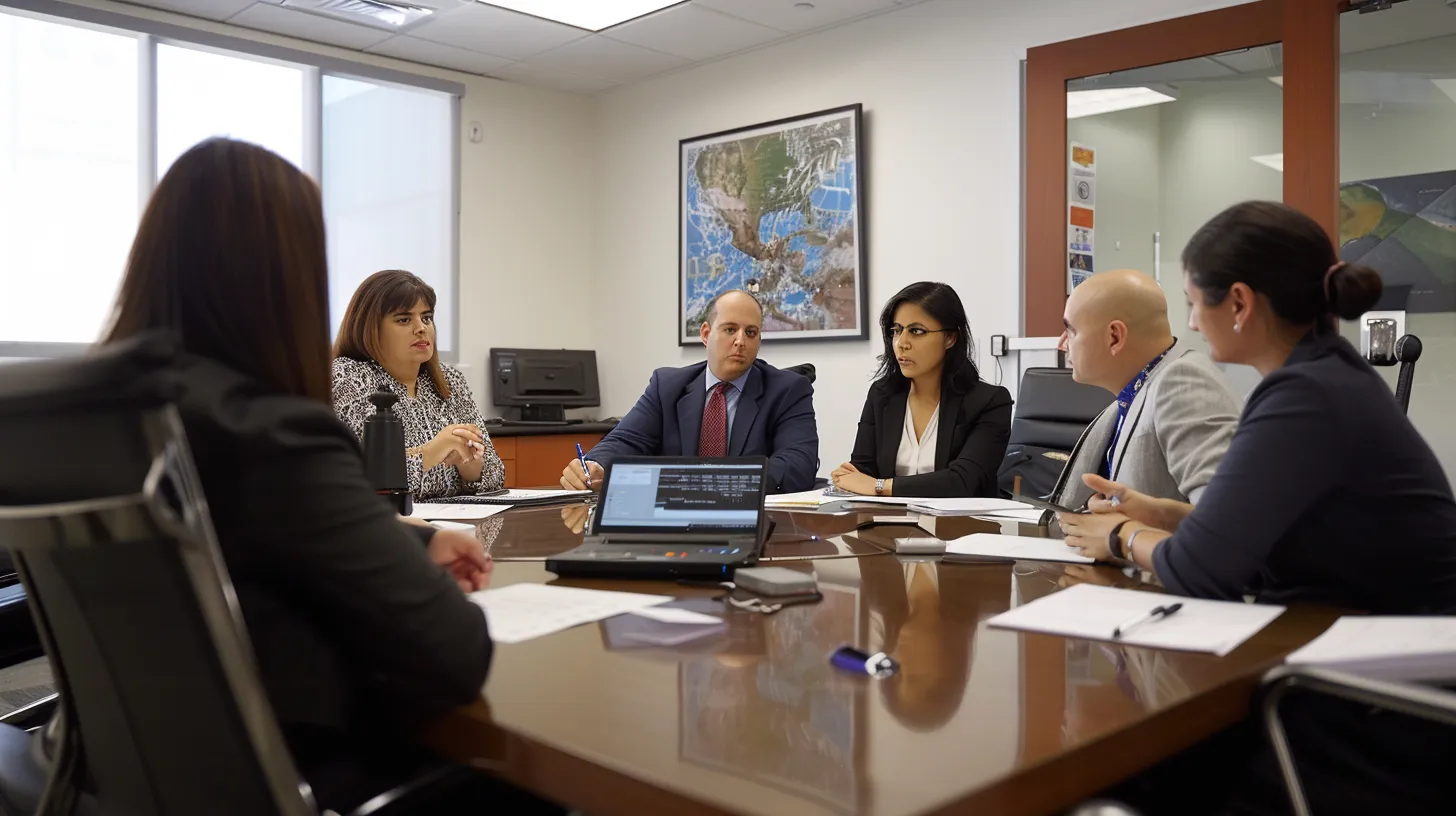Texas Car Accidents Analysis delivers reliable daily data that matter to Texas drivers and victims. This post reviews key statistics, explains common causes, and examines the injuries and law enforcement impact on accident outcomes. Readers will gain clear insights and practical legal advice to help manage the challenges following a Texas car accident.
Key Takeaways
- daily traffic data highlights varied hazards including weather, distraction, and mechanical failures
- legal strategies rely on thorough evidence and prompt documentation in accident cases
- law enforcement’s detailed accident reports support effective personal injury claims
- community initiatives and safety courses help improve driver awareness and reduce accident risks
- focused legal guidance assists accident victims in securing fair compensation for injuries
Review the Latest Statistics on Texas Car Accidents

The review explores daily traffic incident rates across Texas, examining accident trends by type and cause. It addresses the effects of weather conditions and identifies the most dangerous texas roads for drivers.
The analysis also considers demographic influences and the impact of texting while driving, speed, and vehicle accidents, providing insights that support a car accident lawsuit and enhance overall road safety.
Examine Daily Traffic Incident Rates Across Texas
Daily traffic figures across Texas reveal a steady stream of incidents ranging from minor collisions to serious car crash events. Analysis shows that factors such as product liability claims and accidents involving SUVs contribute to the overall traffic complexity, drawing parallels with similar trends observed in North Carolina areas.
Authorities monitor daily accident rates to improve road safety and address recurring traffic issues effectively. The data reinforces the need for greater driver awareness, particularly among those prone to distractions or aggressive driving, which may lead to car crashes and potential product liability litigation when vehicle failures occur.
Analyze Trends in Accident Types and Causes
The analysis indicates that accident patterns in Texas reflect notable variations by cause. The national highway traffic safety administration data supports trends that relate closely with established law and traffic safety standards, offering proof that defensive driving practices can help minimize risks. The findings echo studies conducted in states like Rhode Island, where community initiatives emphasize measured driving behavior.
Data reveals that human errors, mechanical breakdowns, and adverse weather are significant contributors to accident types. Through monitoring incident trends and applying defensive driving principles, traffic safety professionals implement strategies that align with law enforcement efforts, as supported by national highway traffic safety administration research and experiences noted in cases from Rhode Island.
Assess the Impact of Weather Conditions on Accidents
Weather conditions play a significant role in Texas traffic, with rain, fog, and high winds substantially increasing the risk of car accidents Houston area drivers face. Observations show that poor weather can lead to vehicle control issues and, when combined with driver negligence, heighten the likelihood of car accidents, leaving many car accident victims dealing with added stress while navigating impaired road conditions.
The fluctuating weather challenges drivers to adjust speed limits safely, as reduced visibility and slick roads demand cautious navigation. Traffic analysts note that stringent adherence to speed limit guidelines can minimize accidents, making it essential for drivers to remain vigilant and avoid potential pitfalls that stem from adverse weather conditions.
Identify the Most Dangerous Texas Roads for Drivers
Recent statistics indicate several Texas roads have earned a reputation for high-risk intersections and frequent collisions, posing challenges for drivers and affecting both personal injury claims and property concerns. These findings urge San Antonio residents and visitors to pay focused attention when navigating these critical roadways:
| Road Condition | City | Key Factors |
|---|---|---|
| Busy Intersection | San Antonio | High traffic volume; frequent property damage |
| Urban Thoroughfare | Dallas | Driver distraction; personal injury risks |
Data from recent crash records underscores the need for improved vigilance at hazardous intersections and problematic road sections. By addressing these high-risk areas, law enforcement and city planners work to reduce accident rates, protect property, and lower the incidence of personal injury incidents across the state.
Explore Demographic Factors Influencing Accident Rates
Recent reviews of demographic data show that drivers in Houston, especially young and middle-aged groups, face a higher risk of crash events near busy corridors such as Interstate 45 and at intersections with stop signs. Statistic evidence underscores disparities in driving behavior that experts use to support proactive safety measures and targeted legal advice in personal injury cases.
Analyses from various regions reveal that demographic influences affect daily accident figures, with variations observed between urban environments and suburban areas, particularly around areas with malfunctioning stop sign designs and high-traffic interstate sections like Interstate 45:
| Location | Risk Factor |
|---|---|
| Interstate 45 | Heavy traffic and speed variations |
| Urban Stop Sign Area | Driver inattention leading to crash incidents |
This structured information assists analysts in refining safety protocols and aids legal professionals in presenting clear, data-based arguments in accident litigation.
Understand the Role of Distracted Driving in Statistics
The analysis shows that distracted driving significantly impacts motor vehicle accidents in urban areas, as driver behavior can quickly worsen road conditions. Experts note that even minor lapses in attention can lead to accidents in Houston, emphasizing the need for constant vigilance among drivers.
Data reflects that distractions while driving contribute to dangerous road events, with statistical correlations between inattention and the frequency of motor vehicle accidents. Legal specialists advise that understanding this behavior is critical for arguing personal injury claims effectively in urban cases.
Identify Common Causes of Car Accidents in Texas

This section reviews key causes of car accidents in Texas, including speeding and reckless driving, alcohol use with implications of driving under the influence and drunk driving, distracted behavior, poor vehicle maintenance, adverse weather, and driver fatigue. Insights from Houston car accident cases add context to the risks and support refined safety practices.
Investigate Speeding and Reckless Driving Incidents
Robert J. Heil’s analysis shows that speeding and reckless driving account for a significant percentage of daily car wrecks in Texas, where crashes frequently lead to extensive pain and suffering. His team uses firsthand data to support legal arguments, ensuring that victims receive compensation for injuries and losses, including issues related to premises liability.
The professional evaluation of these incidents highlights that accelerated driving behaviors elevate risks on busy highways and intersections. By documenting each crash with practical examples, Heil’s firm reinforces the need for strict adherence to speed limits, aiding clients in their personal injury cases with clear insights into the factors that worsen accident severity and related pain and suffering.
Analyze the Effects of Alcohol and Substance Use
The analysis shows that elevated blood alcohol content significantly increases the risk of a texas car accident, especially in motor vehicle cases where impaired judgment leads to severe injuries. The findings highlight that even a slight impairment can make handling a motorcycle or any other vehicle dangerous, urging a careful review of substance use in transportation incidents.
Data indicates that incidents in georgia and across Texas are consistently linked to alcohol and substance use, demanding clear legal arguments in accident cases. Experts assert that monitoring blood alcohol content levels is crucial when evaluating the responsibility in motor vehicle incidents, providing vital support for personal injury claims.
Highlight the Dangers of Distracted Driving Behaviors
Distracted driving behaviors significantly elevate the occurrence of auto accidents and potential injury. Detailed data collected by heillawfirm.com confirms that even short moments of inattention often lead to severe incidents, impacting the reliability of car accident claims.
Experienced legal professionals recognize that driver distraction plays a key role in complicating injury cases stemming from auto accidents. Practical examples shared on heillawfirm.com underline how focused attention behind the wheel can reduce risks and support stronger car accident claims.
Discuss Issues Related to Inadequate Vehicle Maintenance
Inadequate vehicle maintenance increases the risk of highway collisions, which can compromise overall safety and lead to complications with police investigations. Poor upkeep often results in malfunctioning brakes and tires, costing drivers more than just a wage lost after an accident and putting pedestrians at risk on busy roadways.
Experts note that failing to regularly service vehicles can cause unpredictable performance and equipment issues that police frequently encounter at accident scenes. This oversight not only raises repair costs but also undermines community safety, highlighting the need for diligent maintenance to protect all road users.
Explore the Risks of Driving in Adverse Weather
Driving in adverse weather imposes significant risks on road users, as poor visibility and slippery surfaces often lead to unpredictable accidents. Authorities use the fatality analysis reporting system to track these incidents, and cases of an Austin car accident linked to severe weather conditions serve as a practical example of the dangers drivers face, which sometimes escalate into road rage situations. For expert evaluation of such incidents, individuals are encouraged to contact us.
Weather-related challenges amplify the risks of an accident, especially when drivers fail to adjust speed and maintain safety precautions. Data from the fatality analysis reporting system combined with instances of an Austin car accident point to a clear connection between harsh weather conditions and increased accident rates, including cases complicated by road rage. Legal professionals advise that drivers should contact us to understand further the risks and protective measures available in these situations.
Assess the Prevalence of Driver Fatigue in Texas
Driver fatigue significantly contributes to car crashes, as diminished alertness can cause delayed reaction times during a traffic collision. Data from a dallas car accident investigation shows that even a brief moment of drowsiness leads to dangerous maneuvers, such as tailgating, which often triggers subsequent incidents on busy roads.
The analysis addresses the risks associated with driver fatigue in dallas environments, where prolonged driving and limited rest periods are common. Evidence from recent studies indicates that fatigue not only raises the likelihood of tailgating but also increases the chances of a critical traffic collision, urging the need for proper rest and caution behind the wheel.
Discuss the Injuries Sustained From Texas Car Accidents

This section reviews common physical injuries from collisions, examines psychological effects, and analyzes long-term consequences. It identifies vulnerable groups facing severe impacts while discussing healthcare costs and rehabilitation options. The insights align with personal injury legal services in new jersey and support wrongful death, slip and fall, and car accident claim cases with practical guidance.
Review Common Physical Injuries in Automobile Collisions
Car accidents often result in shoulder injuries that affect daily activities and long-term mobility. The national safety council data supports that these injuries, alongside other trauma, disrupt prospects for a full recovery and raise concerns about the adequacy of insurance claims in covering ongoing medical costs.
Serious collisions also carry an increased risk of death, reinforcing the need for prompt medical assessment after an accident. Legal experts note that comprehensive insurance policies and expert evaluations help address the financial and physical burden of such injuries, ensuring that victims receive proper support and compensation.
Examine Psychological Effects of Car Accidents on Victims
Victims of a car accident often face significant psychological effects after the incident, with stress and anxiety emerging as common outcomes. Research from the insurance institute for highway safety highlights that the use of a seat belt may reduce physical injuries, but does not necessarily shield victims from long-lasting emotional distress, as seen in cases involving a truck driver or even accidents reported from north dakota.
Emotional challenges such as post-traumatic stress and depression can arise unexpectedly, prompting victims to seek professional guidance as soon as possible:
- Anxiety following the accident
- Post-traumatic stress symptoms
- Depressive moods and mood swings
- Ongoing concerns about road safety
Evidence from various car accident cases suggests that understanding these psychological impacts leads to better recovery strategies and informed insurance claims, affirming that targeted therapy can benefit those in need. Professional insights underline that comprehensive case reviews, including detailed accounts of the accident circumstances, help legal teams build stronger arguments for fair compensation.
Analyze the Long-Term Consequences of Accident-Related Injuries
Long-term consequences of accident-related injuries can include ongoing pain and diminished quality of life, which often lead victims to face substantial property damage and mounting medical expenses. Legal professionals note that presenting clear evidence of fault is crucial when preparing a lawsuit or pursuing a wrongful death claim, as in cases where the texas department of transportation is involved in accident investigations.
Injury complications may persist for years after the initial incident, impacting both physical abilities and financial stability. Experts emphasize the importance of early intervention and comprehensive legal support to address issues arising from extensive property damage, ensuring that those affected are well-prepared to support their lawsuit and related claims.
Identify Vulnerable Groups at Risk of Severe Injuries
Research indicates that vulnerable groups, such as the elderly and young drivers, are at a greater risk of sustaining severe injuries in Texas car accidents, where factors like truck collisions increase the potential for extreme pain and lasting damages. The firm stresses that distraction, including that caused by internet usage while driving, plays a critical role in these incidents, urging affected individuals to seek expert legal guidance to protect their rights.
Statistical reviews point to the fact that injuries from accidents involving large trucks often result in significant pain and long-term damages for certain demographic groups. Expert legal teams emphasize that addressing distractions and other contributory factors is essential in securing fair compensation and preventing further harm to high-risk drivers.
Discuss Healthcare Costs Associated With Treatment
Healthcare costs following traffic accidents can place a significant risk on passengers and drivers, especially after serious injuries occur. Legal experts note that treatment expenses often rise rapidly, with medical bills for emergency care and rehabilitation adding a serious burden on accident victims.
In many cases, the financial impact of treatment after accidents can lead to long-term challenges for victims, with costs escalating due to extended hospital stays and therapy sessions. Professionals emphasize that understanding these costs is crucial in planning compensation cases related to traffic accidents.
Explore Rehabilitation Options for Accident Victims
Rehabilitation options for accident victims offer practical pathways for recovery after a Texas car accident, addressing both physical and emotional challenges. This professional analysis underscores the need for tailored treatment plans, including physical therapy, pain management, and psychological support that cater to individual recovery needs:
- Physical therapy programs
- Pain management strategies
- Counseling and support services
Specialized rehabilitation centers in Texas work closely with injury victims to improve mobility and reduce ongoing pain following a car accident. Legal and medical experts emphasize the importance of early rehabilitation, providing actionable insights that contribute to effective recovery and long-term well-being.
Analyze the Role of Law Enforcement in Texas Accidents

Police procedures after accidents include thorough on-scene investigations, issuing traffic citations, and preparing detailed reports. Law enforcement evaluates public safety campaigns and collaborates with local communities to reduce collisions. They also monitor response times closely to enhance overall safety, helping reduce accident rates across Texas.
Outline the Procedures Followed by Police After an Accident
Following a Texas car accident, police systematically secure the scene by gathering evidence and recording witness statements to establish a clear account of the incident. They document vehicle positions, measure skid marks, and photograph damage to provide a factual basis that supports later legal evaluations and compensation claims.
The officers then prepare detailed reports that outline the sequence of events, noting any traffic code violations and contributing factors. This methodical approach ensures that every incident received is thoroughly investigated, aiding both law enforcement efforts and personal injury legal professionals in building a strong case for justice.
Discuss the Process of Issuing Traffic Citations and Reports
The process of issuing traffic citations begins with law enforcement officers collecting evidence at the scene, followed by meticulously recording vehicle positions and any visible infractions. This approach ensures that essential details naturally support later legal procedures and solidify personal injury claims when necessary:
- Gathering witness statements
- Documenting traffic violations
- Recording incident details
Reports are prepared shortly after the accident, detailing every step taken during the investigation. These reports play a crucial role in informing legal strategies for car accident cases, offering a clear and practical guide for those seeking justice through personal injury claims.
Evaluate the Effectiveness of Public Safety Campaigns
Public safety campaigns in Texas have shown measurable results, with enhanced driver awareness contributing to reduced rates of accidents on busy roadways. Law enforcement efforts paired with well-targeted messages have helped inform drivers of real-time risks and safe driving practices, ultimately supporting better traffic safety outcomes.
Authorities note that ongoing campaigns play a vital role in educating the community about cautious driving and accident prevention. Strategic partnerships between police, local organizations, and media outlets have proven effective in lowering collision rates and promoting a safer driving environment throughout Texas.
Assess How Enforcement Affects Accident Reduction
Law enforcement in Texas plays a pivotal role in reducing accident rates by enforcing traffic regulations and responding swiftly to incidents. Their proactive measures, such as increased monitoring and implementation of traffic safety policies, directly contribute to safer road environments and better outcomes in personal injury cases.
Enhanced enforcement efforts have led to noticeable declines in traffic violations and car accidents across the state. By clearly documenting incidents and supporting legal processes, police work facilitates informed strategies that help diminish accident frequency and support victim compensation.
Explore Collaborations With Local Communities on Safety
Local authorities work with community groups and neighborhood associations to promote safer driving practices throughout Texas. This collaboration involves sharing updated traffic statistics and actionable safety strategies, which strengthen the efforts of law enforcement in reducing car accidents and addressing common road hazards.
Community meetings and safety workshops are organized to engage residents in understanding traffic trends and the importance of vigilance on Texas roads. Such collaborative initiatives reinforce law enforcement messages and provide personal injury clients with practical steps to protect themselves on the road.
Investigate the Response Times of Law Enforcement Agencies
Law enforcement agencies in Texas consistently aim to minimize response times at accident scenes, a key factor in reducing injury severity and ensuring swift care for those involved in car accidents. Practical insights from recent investigations reveal that faster arrival times support more effective accident management and strengthen the foundation for personal injury claims.
Data shows that efficient response times not only improve safety outcomes but also help law enforcement gather critical evidence more quickly. This proactive approach strengthens legal cases by providing clear, timely documentation and support for victims affected by Texas car accidents.
Explore Legal Considerations Following a Car Accident

This section covers key legal issues such as determining liability and fault, the process for filing insurance claims, and the role of personal injury attorneys in Texas. It reviews potential compensation for damages, emphasizes the need for prompt legal action, and evaluates the impact of state laws on accident claims.
Understand Liability and Fault Determination in Accidents
Determining liability and fault in car accidents is essential for guiding personal injury claims effectively. A clear understanding of the process, including evidence collection and witness documentation, helps build a strong case for compensation when disputes arise:
| Step | Action | Outcome |
|---|---|---|
| Investigation | Collect evidence and record witness statements | Establish clear responsibility |
| Analysis | Assess driving behavior and vehicle conditions | Identify key factors in the accident |
| Determination | Apply legal standards to assess fault | Weigh responsibilities for accurate compensation |
The evaluation of accident liability is guided by objective criteria that examine driver actions, environmental factors, and vehicle conditions at the time of the incident. Expertise in interpreting this evidence enables professionals to advise victims effectively, ensuring that the responsible parties are held accountable and that compensation claims are substantiated with practical examples.
Explore the Process of Filing Insurance Claims
Legal professionals explain that the process of filing insurance claims after a Texas car accident begins with prompt documentation of the incident. A thorough record of the accident details, including photographs and witness statements, supports a clear claim submission and helps streamline the review process by the insurance company.
Experts note that following specific state guidelines when filing insurance claims can significantly impact the outcome of a personal injury lawsuit. Accurate and timely communication with the insurer, supported by detailed evidence, ensures that claimants’ rights are protected and that compensation for damages is pursued effectively.
Identify the Role of Personal Injury Attorneys in Texas
Personal injury attorneys in Texas offer direct guidance and support following car accidents, ensuring victims understand the legal process and their rights. Their expertise in handling complex accident claims provides a clear path to secure fair compensation, easing the burden on those who have suffered injuries and property loss.
These legal professionals work diligently to gather vital evidence, assess liability, and present robust cases to support personal injury claims in Texas. Their focused approach combines practical experience and deep knowledge of state laws to help accident victims achieve a satisfactory result in their legal battles.
Review Potential Compensation for Accident-Related Damages
Texas car accident victims may secure compensation that covers medical expenses, lost wages, and property damage. Personal injury attorneys emphasize the importance of thorough evidence collection to support claims and achieve fair settlements. This approach assists victims by ensuring each aspect of their accident-related damages is properly evaluated and compensated.
Legal professionals in Texas advise that evaluating accident-related damages requires a clear understanding of each claim element. Expert opinions back a targeted strategy for compensation that addresses both immediate and long-term financial burdens. This method gives car accident victims a stronger negotiating position when pursuing personal injury claims.
Discuss the Importance of Timely Legal Action
Timely legal action after a car accident ensures that vital evidence is preserved and witness recollections remain fresh, strengthening the foundation of a personal injury claim. By addressing issues quickly, legal professionals help victims secure the compensation they deserve while preventing further complications in the claims process.
Prompt legal intervention improves communication with insurance companies and supports clear documentation of accident details. Experienced attorneys advise that swift action can mitigate the challenges of disputed responsibility and expedite the recovery of damages for injured parties.
Evaluate the Impact of State Laws on Accident Claims
Texas state laws play a significant role in shaping accident claims, providing clear guidelines for establishing liability and determining compensation in car accident cases. Professional legal teams utilize these laws to support strong personal injury arguments and ensure that accident victims receive fair settlements.
Experts note that state rules impact evidence evaluation and claim processing timelines, which can affect the final outcome of an accident claim. Lawyers specializing in personal injury cases emphasize that understanding these legal standards helps clients navigate the claims process with confidence and achieve optimal recovery results.
Engage With Resources for Texas Car Accident Victims

Local support groups, medical and psychological resources, legal assistance steps, driving safety courses, and community initiatives are available for Texas car accident victims. Educational programs for young drivers also provide key insights for safer roads. Each resource offers practical help and expert guidance to support victims navigating accident recovery and safety improvements.
Provide Links to Local Support Groups and Organizations
Local support groups and organizations offer essential guidance to Texas car accident victims, connecting them with professionals who understand their immediate needs. These resources provide direct links to assistance services, ensuring that victims have access to both legal and emotional support during recovery.
Community organizations actively share updated information via their websites and social media channels, making it easy for those affected by car accidents to find local help. This network of support groups empowers victims with practical assistance and reliable referrals, facilitating smoother recovery and informed decision-making.
Identify Resources for Medical and Psychological Support
Texas car accident victims can access a range of medical support resources, including emergency care facilities and rehabilitation centers known for their expertise in treating injuries from traffic collisions. Expert legal teams often collaborate with these facilities to ensure that accident victims receive timely treatment, which can significantly improve recovery outcomes.
Professional psychological support is also available to help victims manage the emotional stress following an accident. Trusted counseling services and mental health professionals provide guidance that complements recovery efforts, aiding individuals in overcoming anxiety and depression related to traumatic traffic events.
Outline Steps for Obtaining Legal Assistance
Obtaining legal assistance begins with scheduling a consultation with an experienced Texas personal injury lawyer who specializes in car accident cases. Prospective clients are encouraged to review initial case details and ensure their documentation is complete, as this greatly assists legal professionals in evaluating the viability of their claims.
Expert guidance helps accident victims understand crucial steps such as securing evidence, identifying liable parties, and navigating the insurance claim process. This methodical approach ensures that individuals receive personalized support tailored to their unique circumstances, reinforcing their position in personal injury cases.
Highlight Information on Driving Safety Courses
Driving safety courses offer practical training that focuses on reducing risks on Texas roads. These sessions provide clear instructions and hands-on practice that can help drivers improve their attention and reaction times, which is valuable for addressing the daily figures showing car accident trends. The courses are designed to support all road users by offering actionable insights into safe driving practices.
Texas drivers benefit from tailored driving safety courses that emphasize realistic scenarios and proper handling techniques. Experts note that these courses help lower the occurrence of collisions by educating drivers on the effects of distractions and impaired driving, making them an essential resource for anyone looking to improve their driving skills and overall road safety.
Discuss Community Initiatives for Safer Roads
Local authorities and community organizations in Texas work together to improve road safety through targeted initiatives. These efforts include public safety campaigns, neighborhood meetings, and collaborative events that offer practical safety tips and real-time updates on traffic trends, making it easier for residents to understand and avoid high-risk areas.
Community-led programs provide valuable support to car accident victims by promoting efforts to reduce accidents on busy roads. These initiatives create a network of resources that help drivers recognize potential hazards, reinforcing safe driving techniques and contributing to a noticeable drop in accident rates across the state.
Explore Educational Programs for Young Drivers
Educational programs for young drivers in Texas offer practical training and clear guidance to reduce car accident risks by focusing on defensive driving skills and awareness on the road. These programs equip high school and college students with essential tools and strategies, easing the transition from learner to responsible driver while addressing daily figures related to car accidents.
Local driving courses and workshops provide hands-on practice and expert advice tailored to young drivers, improving reaction times and hazard recognition:
| Program Type | Focus Area | Benefit |
|---|---|---|
| Defensive Driving Course | Hazard Awareness | Reduced risk incidents |
| Practical Workshops | Real-world Scenarios | Improved decision-making |
Conclusion
The analysis clearly highlights daily crash figures, emphasizing that Texas car accident data drives safety improvements and legal strategies. Local law enforcement, legal professionals, and community groups use these insights to enhance road safety and address common risk factors. The review exposes the driving behaviors and environmental conditions that escalate risks, urging drivers to improve their habits. This detailed examination empowers accident victims and policymakers with informed guidance for reducing future incidents and securing fair compensation.







